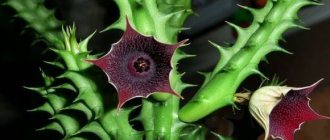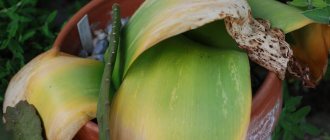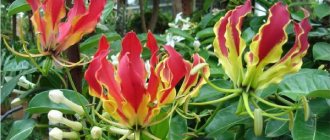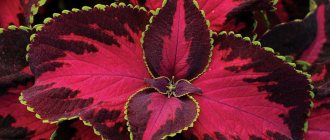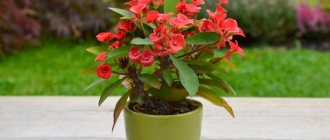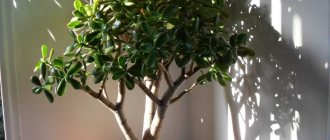Varieties and types
Allamanda oleandrofolia is a shrub reaching up to 90 centimeters in height, quite often found with climbing, drooping shoots. The leaves are elliptical, short-petioled, pointed-elongated, with a dark green color on the upper side and a lighter shade on the lower side, reaching up to 12 centimeters in length. The flowers have a yellowish tint and are located on long stalks, reaching up to 4 centimeters in width, with a swollen corolla tube.
Allamanda laxative is one of the most popular species in cultivated cultivation. It is a climbing plant reaching up to 6 meters in length. The leaves are ovate-elongated, opposite, often glabrous, have pubescence only in the lower part of the shoot, are quite large, reaching about 14 centimeters in length and 2-4 centimeters in width. The flowers are golden-yellowish in color with a whitish base, which are collected in the apical part of the shoot, tubular-funnel-shaped, quite large, up to 5-6 centimeters wide. There are also many forms in cultivated cultivation, but a number of authors evaluate them as independent species.
Allamanda nobilis differs from laxative in its large elongated lanceolate sessile leaves and reddish shoots; foliage reaches up to 20 centimeters in length. The tops of the leaf cover are pointed, the lower part is pubescent. There are 2-3 leaves in the internodes. The flowers are golden yellow in color with a light spot in the throat, reach up to 12 centimeters in diameter, the aroma is very pleasant, somewhat reminiscent of magnolias.
Allamanda Henderson
It stands out from all varieties for its rapid growth. The leaves are thick, leathery, collected in 3-4 pieces. The flowers are orange-yellow with light spotting and reach up to 12 centimeters in diameter.
Allamanda grandiflora, due to its thin climbing shoots, can be grown as an hanging plant; rather slow growth has been observed. The leaf cover is ovate-lanceolate, quite small. The flowers are lemon-yellow in color, reaching up to 10 centimeters in diameter.
Allamanda Schotta is a fast-growing vine with pubescent shoots and warty branches. The leaf cover is lanceolate and wide, collected in 3-4 leaves. The flowers are yellow in color with brown stripes and a dark yellow throat.
Allamanda violet is a rather slow-growing vine with densely pubescent, elliptical leaves, reaching up to 10-15 centimeters in length, collected in groups of 4. The flowers are light purple in color, concentrated on the tips of the shoots in 2-3 pieces.
Diseases and pests
For various reasons (usually due to improper care), allamanda is affected by diseases and pests, as evidenced by changes in the appearance of the plant:
- allamanda leaves curl - the plant is cold (move to a warm place);
- allamanda does not bloom - irregular pruning, nutritional deficiency, little light (regularly prune, feed, move to a brighter place);
- allamanda droops - lack of moisture in the heat or excessive watering during the dormant period; the plant is cold (adjust watering; move to a warmer place);
- allamanda leaves turn yellow - lack of nutrients, little light (feed; move to a brighter place);
- allamanda leaves turn black - excessive watering in cold weather (move to a warm place, treat the plant with a fungicide; replant or propagate by cuttings);
- the plant is stretched - insufficient lighting, lack of nutrients (move to a brighter place, feed).
Sometimes the allamanda is attacked by whiteflies, aphids, and spider mites. From them, the plant is first bathed in the shower, then treated with an insecticide.
Allamanda home care
Allamanda is a light-loving plant that tolerates light exposure to direct sunlight. It is best to place the plant on windows facing south, southeast and southwest. The plant is well suited for landscaping bright winter gardens and greenhouses.
In summer, the plant needs to provide a temperature range of 20 to 24 degrees. And in the period from November to February it is necessary to create favorable conditions for the dormant period, reduce watering and keep the temperature to 15-18 degrees. Draft has a bad effect on plant development.
Watering and air humidity
In summer, the allamanda vine needs abundant watering, but do not allow the soil to become too waterlogged or dry out. In winter, moderate watering is provided after the top layer of soil has dried.
When keeping allamanda, it is necessary to ensure favorable air humidity within 60-70 percent. For this reason, the plant needs frequent spraying during the growing season, while water should be avoided on the flowers, as this may impair their decorative effect. Also, the dishes with the plant can be placed on wet expanded clay or pebbles, but so that the dishes do not touch the water.
Allamanda pruning
At the end of November, in order to improve the flowering period of the allamanda, pruning is done.
In this case, they are cut to half the height of the shoots, above the leaf internodes, or pinching is used for young shoots. It is also necessary to carry out cleansing pruning from thickening and weak shoots throughout the growing season. The stem part of the plant must be tied to supports, as they are not strong enough.
Be careful and use gloves, as the milky sap of the plant is poisonous!
Replanting soil and fertilizers
Allamanda needs feeding with mineral and organic fertilizers, which are applied every three weeks in normal concentrations, during the period of active growth.
In the spring, after flowering, allamands require replanting, young specimens annually, and older ones as needed, approximately once every two to three years.
The soil mixture can be composed of:
- 2 parts leaf and 1 part turf soil, 2 parts peat and 1 part humus, with the addition of 1/3 part sand.
- 1 part turf soil and 2 parts deciduous soil, 5 parts humus, 1 part sand and 1 part peat.
Allamanda: description of the flower
Yellow Allamanda: photos of flowers
Allamanda is a plant that belongs to the Kutrov family, and at the same time, in general, not many gardeners know about it, even those who already have experience in growing a wide variety of crops. The plant was bred in Brazil, but then gradually spread to other territories, where it took root well and gave excellent results, especially when it comes to its decorative properties and features. In this article we will give a more detailed description of this plant, talk about its most striking features and characteristics, and also highlight the varieties of Allamanda, which are also gaining popularity in various regions, but at the same time, gardeners do not have much information about this plant . Thanks to this article, we will try to fill the existing gaps and demonstrate all the advantages and possible disadvantages of this plant.
Allamanda is an evergreen tropical plant that has a rather attractive appearance. Its stems are very long, covered with glossy oval-shaped leaves and a deep, juicy green hue. In this case, the whorl can contain from three to four leaves at a time. The inflorescences are apical tassels, and the buds usually form around the summer at the very tips of the stems. The buds themselves are opening yellow tubular flowers; their diameter can reach ten centimeters, but this is rather in the best and most favorable case. At the same time, the plant, during planting and subsequent growth, necessarily needs additional support, since the stems, although strong, are quite flexible, and therefore they can sometimes bend, which can lead to them becoming very susceptible to various damages. It is also worth remembering that Allamanda is a plant that needs constant warmth, humidity and, most importantly, it does not tolerate shade or partial shade at all, so it is recommended to choose well-lit areas for planting.
Allamanda can reach a height of more than two meters, on average 2.4 meters. In this case, the plant can be trimmed, and then it will be much shorter in height, or you can not trim it, then it will reach its maximum height. In addition to the standard, classic varieties, there are also dwarf varieties of allamanda; their height reaches only 38 centimeters, which, of course, is ideal for planting a dwarf allamanda in a pot right in your apartment. But we'll talk about this a little later.
Yellow Allamanda: photos of flowers
Propagation by cuttings
When propagating by cuttings, semi-lignified shoots about 8-10 centimeters in length are cut off, which are rooted in wet sand. If faster rooting is necessary, the cuttings are treated with growth stimulants and bottom heating of the soil is provided. Newly planted cuttings need constant ventilation and spraying and are kept within a temperature range of 22 to 25 degrees.
After the cuttings take root, they are planted in soil made up of equal parts of humus soil, turf soil, with the addition of sand. And after about 1-1.5 months, the plant is provided with the usual care, as for adult allamandas.
Reproduction of allamanda
Allamanda can be propagated at home in two ways:
growing allamanda from seeds
Held in the second half of February. The seeds are soaked in potassium permanganate, then sown in the ground at a distance of 40 mm from each other, buried by 0.5 cm. They are germinated under the film in a warm place, periodically ventilating and watering the seedlings. Usually after 60 days shoots appear. Then the film is removed, and when 3 true leaves appear, the plant is transplanted into separate containers.
Allamanda propagation by cuttings
It is carried out in the spring by cutting off fragments 10 cm long from strong branches. They are treated with a solution of a root formation stimulator and planted in the ground under a plastic cup, making several holes in it so that condensation does not accumulate. The appearance of leaves will indicate the rooting of the plant. When the leaves grow, the cuttings are transplanted into a small pot.
Vegetative propagation is faster and easier, so it is used more often.
Possible difficulties
- Rotting or blackening of the base of the stem and root collar, possible causes may be excess soil moisture, high seeding density or lack of lighting. This can lead to the plant becoming infected with Blackleg. It is necessary to ensure proper watering and good lighting.
- The leaves are pale and turn yellow, the growth of the plant has slowed down, the stems have become elongated, and flowering is not stable; this may be due to a lack of nutrients or lack of lighting.
- Leaves turn brown and curl, which occurs due to excessively wet soil and a supercooled plant.
- Allamanda can be damaged by pests such as spider mites, nematodes, aphids, and whiteflies if proper care is not provided at home.
Allamanda care, care and maintenance
Proper planting of allamanda is only a small part of home care. In order for an exotic beauty to settle in your home for a long time, it is necessary to create conditions for her that are as close as possible to the natural habitat of the allamanda. To do this, the following factors should be taken into account: lighting, air temperature, humidity and watering.
The most suitable location for an allamanda indoor plant is any south window. Allamanda loves light. In this case, the lighting should not be too intense. Moderate amounts of direct sunlight are allowed on the plant. If the sun shines on the exotic beauty all day, the leaves may burn. In winter, on the contrary, it is necessary to take care of additional lighting.
An important factor for the comfortable living of allamanda is the air temperature. In the warm season it should be from +20°C to +25°C, in the autumn-winter period from +15°C to +19°C. Lower temperatures will be uncomfortable for the allamanda and the plant may die. The worst enemy of a tropical guest is a draft, so when placing the plant it is necessary to take this factor into account.
Problems during cultivation
- Alamenda withers and droops in the summer with insufficient watering, in winter, on the contrary, if the watering is too abundant and/or the temperature is too low;
- Yellowing of the foliage and stretching of the shoots indicates that the plant does not have enough lighting or there are insufficient nutrients in the soil;
- Leaves curl and change color when kept in too low temperatures;
- Leaves turn brown at low temperatures, dampness and excessive soil moisture;
- Alamanda sheds its leaves when exposed to cold drafts and waterlogged soil;
- Blackening of the plant indicates the beginning of rotting, which occurs when the soil is waterlogged in combination with low temperatures. The plant needs to be renewed by re-rooting the cuttings.
Views: 485
Irrigation mode and air humidity
Allamanda does not like drought and can suffer greatly from drying out the earthen clod. During the spring-summer period of vegetative growth, follow the regime of abundant watering. But you shouldn’t get too carried away with water procedures. It’s better to wait until the top earthen ball dries out. In the autumn-winter season, watering is reduced to moderate.
READ MORE: Dracaena types and varieties, planting and care, pruning and propagation, placement in the interior
In the spring-summer season, nutrients are added every 7-9 days. For this purpose, mineral fertilizers are used for flowering plants.
Conditions and care
The plant feels good in a greenhouse or winter garden with a temperature not lower than + 17 degrees. The culture can also be kept in residential premises until it reaches its maximum size. After this, she should still be moved to a winter garden or greenhouse, where there will be plenty of space for her.
Allamanda is a light-loving plant. The room must be provided with high air humidity and a comfortable temperature. If you care for it properly, you will enjoy flowering every year. Caring for an allamanda plant at home is quite difficult, but still possible.
Remember! Allamanda is a poisonous plant! When it gets on the skin and mucous membranes, its juice can cause irritation and itching. Therefore, any manipulations (transplantation, propagation, pruning) with the plant are best done with gloves.
In summer it is better to place the plant on the balcony. Fresh air ensures abundant flowering. But as soon as the air temperature drops to +15 degrees at night, the plant must be immediately returned to the apartment. To maintain a compact shape, the crop should be pruned in early spring, if necessary, to half the length of the stems.
Lighting and location
Allamanda loves a lot of light, so the most favorable conditions for her will be the southern sides. But in hot midday hours it is better to move the plant into the shade to avoid burning its leaves and peduncles. In winter, additional lighting must be installed.
Temperature
The most comfortable temperature for allamanda:
- in the warm season: from +20 to +25 degrees;
- during the cool period: from +15 to +19 degrees.
At lower temperatures, the allamanda may die. Sub-zero temperatures are strictly contraindicated for her. When frost occurs, the plant dies immediately. Allamanda also does not like drafts. This must be taken into account when maintaining this culture at home.
Air humidity
Moderate or high, that is, from 50% and above. To do this, you can place the pot in a tray with wet expanded clay; Spray the plant regularly or use a room humidifier.
The soil
Use nutritious, loose, slightly acidic or neutral soil. You can prepare a mixture of leaf soil, humus and sand.
Landing, transplant
Allamanda does very well in a large and spacious pot. To avoid soil dampness, it is necessary to use a pot with large drainage holes, since the root system is susceptible to rot.
The best self-propelled gasoline snow blowers: TOP 10 models, 2021 rating with description of technical characteristics
Young plants should be replanted once a year, adults - once every two to three years. The transplant should be done in the spring, preferably in March. In order to maintain the compactness of the plant, it is no longer necessary to replant from a container with a radius of 10 cm. It will be enough just to carefully trim the roots and add new soil.
The diameter of the pot for replanting depends on the type of allamanda. It is recommended to transplant fast-growing varieties into large containers with a reserve. For slow-growing plants, a pot that is two to three cm wider in diameter is suitable.
Do not forget that containers for transplantation must have drainage holes.
A newly purchased plant should be replanted no earlier than a two-week quarantine, which allows it to identify possible diseases and pests and adapt to new conditions.
Watering
Allamanda is a moisture-loving plant. But the watering regime is determined by the time of year: in the summer, the soil should be generously moistened. In the cold season, you need to reduce watering, but so that the top layer of soil dries out no more than 5 cm. Water for irrigation should be soft, slightly warm. The plant loves regular spraying.
Tip : when watering, it is advisable to increase the air humidity.
Feeding
In summer-spring and during flowering, the plant should be fed no more than twice a month. Complex fertilizers for indoor plants should be used. You can also alternate mineral and organic fertilizers.
Trimming
Allamanda pruning is carried out in the following cases:
- growth restriction,
- increase in the number of flowers.
It should be produced in February before flowering or in November after it ends.
It is necessary to cut no more than half the length of the branches. You need to cut above the leaf node with the growing point. Dried shoots must be removed. For splendor, you can pinch young shoots.
Description and features
Allamanda is an evergreen perennial that belongs to the Kutrov family. In fact, it is a liana-like or shrub plant with shoots that are flexible. Allamanda was brought from the American tropics. It should be noted such distinctive features as:
- the height of a shrub plant is up to 90 cm, a liana-like plant is slightly higher;
- pointed, elongated leaves in pairs, the color of lush green, the surface is glossy, shimmering;
- trumpet-shaped inflorescences have 5 petals;
- flower size – from 8 to 12 cm;
- possible shades of flowering are quite deep, bright: pink, yellow, cream, white;
- inside the stems there is milky white juice;
- poisonous plant everywhere
Botanical description
Allamanda is a genus of 15 species from the Kutrovaceae family. These are evergreen plants - shrubs and vines. The homeland of exotic guests is South America, in particular the tropical rainforests of Brazil.
Allamanda laxative has gained the greatest popularity among Russian flower growers. It is a shrub that reaches a height of 2 m, or a vine that can grow 5 m in length. The elastic stems are light gray in color, and the leaf blades are arranged oppositely or in whorls of 3-6 pieces. The dark green, outwardly smooth leaves, 6-16 cm long and 2-6 cm wide, have an oblong shape with a wedge-shaped base and narrowed towards the apex. The lower surface of the leaf blade is slightly lighter than the outer surface and may be slightly pubescent.
Large tubular-funnel-shaped bright yellow flowers up to 10 cm in diameter are arranged in apical corymbose inflorescences. Each flower consists of a 5-lobed calyx and a corolla of 5 rounded petals, connected downwards and having a bend, so it looks like a familiar bell. The fruit is a 3-centimeter capsule that opens with 2 doors.
Advice! In summer with warm nights (above 15°C), plants can be kept on a balcony, open terrace or outdoors.
Conditions and care
The plant feels good in a greenhouse or winter garden with a temperature not lower than + 17 degrees. The culture can also be kept in residential premises until it reaches its maximum size. After this, she should still be moved to a winter garden or greenhouse, where there will be plenty of space for her.
Allamanda is a light-loving plant. The room must be provided with high air humidity and a comfortable temperature. If you care for it properly, you will enjoy flowering every year. Caring for an allamanda plant at home is quite difficult, but still possible.
Remember! Allamanda is a poisonous plant! When it gets on the skin and mucous membranes, its juice can cause irritation and itching. Therefore, any manipulations (transplantation, propagation, pruning) with the plant are best done with gloves.
In summer it is better to place the plant on the balcony. Fresh air ensures abundant flowering. But as soon as the air temperature drops to +15 degrees at night, the plant must be immediately returned to the apartment. To maintain a compact shape, the crop should be pruned in early spring, if necessary, to half the length of the stems.
Lighting and location
Allamanda loves a lot of light, so the most favorable conditions for her will be the southern sides. But in hot midday hours it is better to move the plant into the shade to avoid burning its leaves and peduncles. In winter, additional lighting must be installed.
Temperature
The most comfortable temperature for allamanda:
- in the warm season: from +20 to +25 degrees;
- during the cool period: from +15 to +19 degrees.
At lower temperatures, the allamanda may die. Sub-zero temperatures are strictly contraindicated for her. When frost occurs, the plant dies immediately. Allamanda also does not like drafts. This must be taken into account when maintaining this culture at home.
Air humidity
Moderate or high, that is, from 50% and above. To do this, you can place the pot in a tray with wet expanded clay; Spray the plant regularly or use a room humidifier.
The soil
Use nutritious, loose, slightly acidic or neutral soil. You can prepare a mixture of leaf soil, humus and sand.
Landing, transplant
Allamanda does very well in a large and spacious pot. To avoid soil dampness, it is necessary to use a pot with large drainage holes, since the root system is susceptible to rot.
Young plants should be replanted once a year, adults - once every two to three years. The transplant should be done in the spring, preferably in March. In order to maintain the compactness of the plant, it is no longer necessary to replant from a container with a radius of 10 cm. It will be enough just to carefully trim the roots and add new soil.
The diameter of the pot for replanting depends on the type of allamanda. It is recommended to transplant fast-growing varieties into large containers with a reserve. For slow-growing plants, a pot that is two to three cm wider in diameter is suitable.
Do not forget that containers for transplantation must have drainage holes.
A newly purchased plant should be replanted no earlier than a two-week quarantine, which allows it to identify possible diseases and pests and adapt to new conditions.
Watering
Allamanda is a moisture-loving plant. But the watering regime is determined by the time of year: in the summer, the soil should be generously moistened. In the cold season, you need to reduce watering, but so that the top layer of soil dries out no more than 5 cm. Water for irrigation should be soft, slightly warm. The plant loves regular spraying.
Tip: when watering, it is advisable to increase the air humidity.
Feeding
In summer-spring and during flowering, the plant should be fed no more than twice a month. Complex fertilizers for indoor plants should be used. You can also alternate mineral and organic fertilizers.
Trimming
Allamanda pruning is carried out in the following cases:
- growth restriction,
- increase in the number of flowers.
It should be produced in February before flowering or in November after it ends.
It is necessary to cut no more than half the length of the branches. You need to cut above the leaf node with the growing point. Dried shoots must be removed. For splendor, you can pinch young shoots.
Brief description of cultivation
- Bloom . It is observed in May–September. However, indoor allamanda blooms only in conditions as close as possible to natural ones.
- Illumination . Needs a lot of bright light.
- Temperature regime . In winter, from 15 to 17 degrees, and in summer, from 20 to 25 degrees.
- Watering . During the spring-summer period, water abundantly. With the onset of autumn, watering is gradually reduced, and in the winter months it is carried out only when the surface of the substrate dries to a depth of about 30–40 mm.
- Air humidity . It should be elevated. To do this, the bush is systematically moistened with a sprayer, and it can also be placed on a tray filled with wet pebbles or expanded clay.
- Fertilizer . Fertilizing is carried out only during the period of active growth at intervals of 1 time in 20 days; for this purpose organic matter and complex minerals are used. A bush that is at rest is not fed.
- Rest period . It begins in late autumn and ends in early spring.
- Transplant . It is carried out in spring. While the allamanda is young, it is replanted systematically once a year, and older specimens only when necessary (on average, once every 2 or 3 years).
- Support . The bush needs support. It is placed in a pot during transplantation. To do this, you can choose a ladder or an arch.
- Soil mixture . Peat, sand, humus, leaf and turf soil (1:1:5:2:1).
- Trimming . At the very end of the period of intensive growth, all shoots should be shortened by ½ part. And throughout the growing season, all weak stems are systematically cut out.
- Reproduction . Almost lignified stem cuttings and seed method.
- Pests . Whiteflies, spider mites, nematodes and aphids.
- Diseases . Root and stem rot.
- Properties . The juice of the plant contains poison!
Reproduction
Exotic plants can be propagated by seed and vegetative methods.
After flowering, a few flattened seeds with fleshy contents ripen in the fruit-box. They are collected and sown in a light, fertile and well-moistened substrate, covered with glass or polyethylene and kept at 25°C. Minigreenhouses are ventilated daily and soil moisture is monitored. The seedlings should sprout in 3-6 weeks. Young plants retain their maternal qualities.
The easiest way is propagation by cuttings. To do this, in early spring, apical semi-lignified cuttings from last year, about 10 cm in length, are taken. They are rooted in sand or in a moist, light substrate with the addition of sphagnum. For better rooting, you can treat the lower part of the cutting with a biostimulator of root formation and make a mini-greenhouse, covering it with a glass jar. The cuttings are kept in warm conditions of 22-25°C and watered periodically.
